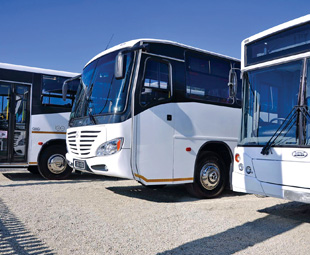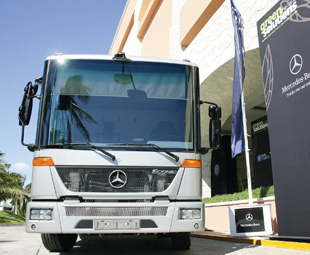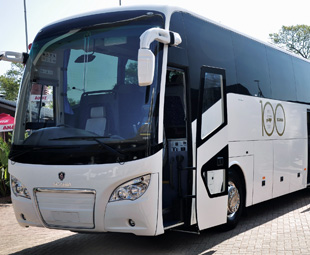BRT: big challenges ahead

Bus rapid transit (or BRT as it’s commonly known) has been hailed as government’s preferred solution for the country’s public transportation dilemma. But some people believe that it’s a flop. What’s the reality? CHARLEEN CLARKE investigates …
Whether you love or hate it, BRT is here to stay. That’s because billions have already been invested in the concept.
According to Frank Beeton, industry analyst at Econometrix and FOCUS industry correspondent, BRT is government’s solution to the “untenable” situation in South Africa when it comes to public passenger transport. “Most people agree that the country needs vastly improved services, and that the present situation is far from acceptable. This has been largely down to a lack of decisive government policy, poor application of the policy that does exist, and minimal regulation of an undisciplined minibus taxi industry that has systematically worked its way into a dominant position in the sector,” he believes.
BRT was a kneejerk reaction to this scenario. “Following its now well-established pattern of inventing something new, rather than fixing existing problems, government has embraced BRT as its preferred solution for the country’s public transportation dilemma. By establishing a business model where taxi owners are given some degree of ownership participation in the BRT systems, it hopes to avoid the sort of interference and downright intimidation that has characterised taxi interaction with other transport modes in the past. BRT contracts based on compensation for distance-related operating costs, rather than passenger subsidies, also leave the choice of modes to the user – thereby insulating the authorities from any accusations of partiality,” he explains.
It is thus that BRT has been rolled out in various cities in South Africa – and, in theory, it’s a good idea. “The BRT concept combines elements of bus and rail operation, by putting large capacity buses and bus trains on reserved right-of-ways, and, by segregating them from normal traffic, allows them to operate at higher average speeds, and at more frequent headways. This should make the level of service highly predictable and convenient.
 “In the South African context, BRT buses also operate under a relaxed regulatory environment, permitting greater axle massloads and increased lengths than those allowed for normal public service vehicles. The use of dedicated BRT lanes with boarding stations on the main routes encourages the use of low- or flat-floor layouts, eliminating the need for passengers to climb stairs when entering or leaving the vehicles,” Beeton explains.
“In the South African context, BRT buses also operate under a relaxed regulatory environment, permitting greater axle massloads and increased lengths than those allowed for normal public service vehicles. The use of dedicated BRT lanes with boarding stations on the main routes encourages the use of low- or flat-floor layouts, eliminating the need for passengers to climb stairs when entering or leaving the vehicles,” Beeton explains.
We currently have BRT operating in Johannesburg and Cape Town. “The initial phase of the Johannesburg system (143 buses) was opened in August 2009, and connects Soweto with the CBD. The initiation of Phase 1B (134 buses), providing an alternate Soweto-CBD route, has now also taken place, while the next phase will extend the network northwards to Alexandra/Sandton. The Cape Town operation was initially launched to service the Soccer World Cup in 2010, followed by permanent West Coast and airport services using 52 buses and, more recently, central city services operating 190 midibuses. By the end of this year, additional services to supplement inadequate Metro Rail frequencies to Khayelitsha and Mitchell’s Plain should be operational,” reveals Beeton.
BRT networks are planned for Rustenburg and Tshwane/Pretoria. BRT was also introduced in Port Elizabeth – but this has proved to be an unmitigated disaster. “A system was launched in Port Elizabeth to transport spectators to the new Nelson Mandela Bay Stadium during the Soccer World Cup in 2010, but has lain dormant since, leaving expensive buses gathering dust in a warehouse. The local municipality and taxi community are still trying to agree on ownership and operational arrangements so that the system can be restarted, and expanded. There is widespread suspicion that these difficulties may be linked to the minibus taxi industry typically protecting its turf against unwelcome competition,” Beeton tells FOCUS.
Additional networks are also being evaluated for roll out in the Durban and East London areas.
Beeton believes that BRT offers a promising solution to local urban transport needs, and deserves a chance to firmly establish its credentials with the travelling public. But not everyone agrees. Vaughan Mostert, senior lecturer in the department of transport and supply chain management at the University of Johannesburg and FOCUS columnist, reckons that BRT in Johannesburg is a complete flop. “Most of the BRT feeder routes rolled out so far are underperforming – not to mention Gautrain’s underperforming bus feeders …” he contends.
Lisa Seftel, executive director of transport for the City of Johannesburg, strongly disagrees. When it comes to Gautrain, she says that its feeders do not perform uniformly well or poorly. “In the peak, some are full and they play an important function. Very few cities have feeders that perform well in the off peak,” she explains. However the City is obviously not responsible for Gautrain.
 When it comes to BRT, Seftel says that the feeders relating to the first phase, which has been in operation since August 2009, generally perform well, especially in the peak. “The second phase was introduced in October this year and the feeders have not been running for very long. These feeders are not performing well due to the fact that they have just been introduced,” she explains.
When it comes to BRT, Seftel says that the feeders relating to the first phase, which has been in operation since August 2009, generally perform well, especially in the peak. “The second phase was introduced in October this year and the feeders have not been running for very long. These feeders are not performing well due to the fact that they have just been introduced,” she explains.
But Mostert argues that this is not the case. “I have tried out the new routes. I was the only passenger on the bus (15:00 on route C5). Admittedly it is early days … The ‘main route’ (T1) has picked up a little and is probably back to about 5 000 passengers in the peak hour. My comments about a flop are definitely valid,” he insists.
Mostert says that BRT in Johannesburg is riddled with problems, which are a combination of several factors. “The main one is the lack of an overarching body to administer public transport and decide on routes, fares, vehicles and schedules,” he tells FOCUS. (Seftel says that the City of Johannesburg is the overarching body to administer public transport scheduled services.)
On this note, Mostert believes that the Gautrain Management Agency may be angling to take over the running of all public transport in the province. “But look at its poor record! Gautrain was on the front page of The Star recently for losing another R700 million which has to be made good by the Treasury! This aspect needs to be exposed!” he stresses.
But back to BRT specifically. Mostert explains that it is run (and financed) by the City of Johannesburg through joint ventures with ex-taxi operators. “I’d like to see the financials, by the way. It’s probably not much better than the Gautrain!” he notes.
Seftel is extremely willing to provide this information. “The total cost of Rea Vaya infrastructure to date (including 1C design work) is R3,8 billion. The total cost of Phase 1B infrastructure including depot and what has been spent to date is R1,7 billion. The expected operating costs per annum for Phase 1B, with full ridership, is R182 million average per year and R2,186 billion over 12 years. The expected revenue for Phase 1B: R168 million average per year and R2,021 billion over 12 years,” she reveals.
One of Mostert’s biggest gripes is that BRT isn’t coordinated with Metrobus, which is also run by the City of Johannesburg. “Through-ticketing between BRT and Metrobus has not been implemented yet. BRT routes are simply being slapped down, some of them totally overlapping with Metrobus, while others go from nowhere to nowhere and have little growth potential,” he contends.
 Seftel denies that this is the case. “It’s true that through-ticketing hasn’t been implemented yet. We hope to do it within the next 12 to 18 months. But Johannesburg’s BRT is absolutely working with Metrobus. We are part of the same city and are looking at working towards the same operational model. BRT is on routes which require a higher level of service and demand, while Metrobus is deployed where a conventional bus is appropriate,” she tells FOCUS.
Seftel denies that this is the case. “It’s true that through-ticketing hasn’t been implemented yet. We hope to do it within the next 12 to 18 months. But Johannesburg’s BRT is absolutely working with Metrobus. We are part of the same city and are looking at working towards the same operational model. BRT is on routes which require a higher level of service and demand, while Metrobus is deployed where a conventional bus is appropriate,” she tells FOCUS.
Mostert reports that the City of Johannesburg is engaging in a “widespread practice” of sending buses empty from one part of the city to another, sometimes over many kilometres, to take up service on another route. Seftel says that this is not happening. “We would never send empty buses from one part of the city to another. One thing we have to realise is that, due to our apartheid settlement patterns, buses come full into the city from Soweto in the morning and go back almost empty because people do not travel in that direction. This is one issue that the executive mayor’s corridors of freedom and transit orientated development seek to address,” she explains.
Furthermore, Seftel stresses that extensive planning has pre-empted the implementation of BRT. However Mostert remains unconvinced. “Not enough thought has gone into BRT route planning or scheduling so far. Transfers from one BRT route to another are going to be a problem. Passenger modules are not always conveniently placed. They are sometimes quite far from intersections and transferring passengers will have to walk considerable distances in some cases. As more routes are added to the BRT network, these problems will increase …” he warns.
It’s clear that the two parties don’t agree on much at this stage. Will BRT sink or swim? Only time will tell. But one thing is certain: either way, BRT is likely to be a part of the daily life of millions of South Africans forever.
Published by
Focus on Transport
focusmagsa





 !
Starting 1 April, every
!
Starting 1 April, every


 FUSO: Driving the Future of Mobile Healthc
FUSO: Driving the Future of Mobile Healthc



 A brand
A brand




 Wondering about the maximum legal load for a
Wondering about the maximum legal load for a 
 The MAN hTGX powered by a hydrogen combus
The MAN hTGX powered by a hydrogen combus


 Exciting News for South African Operators
Exciting News for South African Operators



